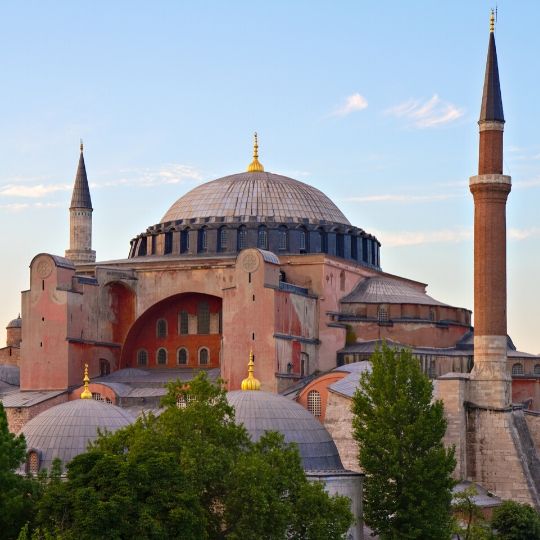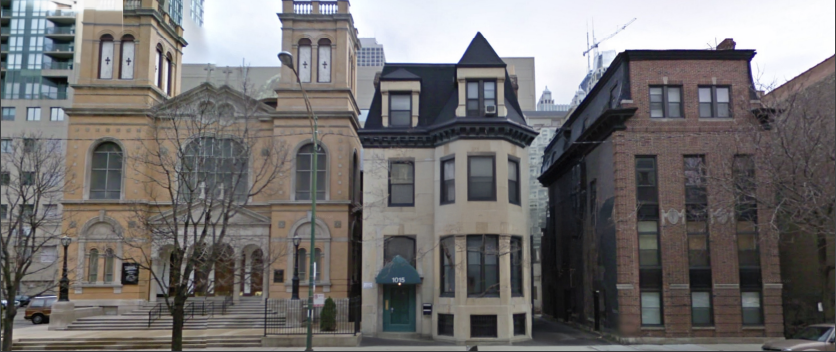“The Uses and Abuses of Hagia Sophia: From the Fall of Constantinople in 1453 to Erdogan’s Neo-Ottomanism in 2020”
Alexandros K. Kyrou
It is no small irony that across the globe the edifice and image most widely associated with Turkey, Istanbul, and even perhaps Islam, is a sixth-century Orthodox Christian church— the magisterial Cathedral of Hagia Sophia, or “Holy Wisdom.” Built by some 10,000 workers between 532 and 537, its patron, Byzantine Emperor Justinian I, inaugurated the construction of Hagia Sophia in the imperial capital of Constantinople with the proclamation that the Church of the Holy Wisdom would be a cathedral like “one that has never existed since Adam’s time, and one that will never exist again.”
Remarkably, Justinian’s boastful claims proved to be as accurate as they were visionary. For virtually a millennium, Hagia Sophia was Christendom’s largest, most revered and awe-inspiring church. Hagia Sophia was the unrivalled ecclesial hearth of the Christian Church before the Western schism, the physical epicenter of the Orthodox Christian world, and the wondrous, breathtaking symbol of Byzantine grandeur and purpose. Indeed, for both contemporaries and historians, Hagia Sophia constituted the greatest achievement of late ancient and medieval architecture, an enduring masterpiece that embodied Byzantine civilization’s quintessential, sophisticated respect and quest for symphony and balance between the ethereal and the physical, majesty and beauty, place and boundlessness, science and mystery, creative genius and humility. Despite Hagia Sophia’s present diminished and abused condition, it is not difficult for even today’s visitor to appreciate the description found in a famous Russian ambassadorial report sent from Constantinople in 987 to Vladimir, Prince of Kiev, of what one encountered upon entering the great cathedral: “We did not know where we were, on heaven or on earth.”
When Constantinople fell to the Ottoman Turks in 1453, virtually all of the city’s surviving cathedrals and churches were—after being desecrated and thoroughly plundered—forcibly seized and turned over to the Turks’ religious establishment to be converted to mosques and used as Muslim properties. The conquering sultan, Mehmet II, personally oversaw the conversion of Hagia Sophia. Crosses were demolished and exchanged for crescents, altars and bells were destroyed, icons were burned or hacked to pieces, mosaics and frescoes depicting Christian imagery were plastered over, and most of the cathedral’s priests were killed or enslaved. In time, four colossal minarets were erected to surround Hagia Sophia, producing the iconic image that has come to be globally associated with Ottoman Constantinople and Turkish Istanbul.
Mehmet took great pride in his belief that he had fulfilled Mohammed’s prophecy: “Verily you shall conquer Constantinople. What a wonderful leader he will be, and what a wonderful army will that army be!” Thereafter, Constantinople and Hagia Sophia represented for the Ottoman Turks much more than merely their empire’s capital and preeminent mosque, respectively. The conquest of Christianity’s greatest city and church was understood by Mehmet and his successors as divine proof of the leading role in the Muslim world to which the Ottoman Empire was entitled, a belief also manifested by the Turks’ subsequent relocation of the Islamic Caliphate to Constantinople.
Indeed, the purpose for the construction of the massive minarets that now tower over Hagia Sophia was to project to the world Islam’s triumph over Christendom’s greatest empire, city, and church. The capture of Hagia Sophia confirmed and symbolized in the Ottomans’ imagination their belief in the superiority of their state and faith over all other nations and all religions, a putative affirmation of their providential role and destiny in history. Hence, the Ottoman Turks formally dedicated their greatest, most celebrated single piece of loot—Hagia Sophia—as Great Fatih Mosque, or “Great Conquest Mosque.”
Despite the Turks’ conviction that their mastery over the great, coveted prizes of Constantinople and Hagia Sophia signaled their inevitable conquest of the remainder of Christian Europe, the Ottoman state showed signs of weakness by the sixteenth century and by the seventeenth century began a long, miserable decline and recession that culminated in the complete dissolution of their empire in the early twentieth century. Led by the Turkish nationalist, Mustafa Kemal, the Republic of Turkey, which emerged in the early 1920s to succeed the Ottoman Empire and to abolish the Caliphate, was officially premised on secularism. Kemal’s modern Turkey rejected the Islamic theocratic system that he and his modernizing nationalists held responsible for the collapse of the old Ottoman order.
In modern Turkey, secularism has produced neither freedom for all faiths nor separation of church and state. Instead, Turkish secularism has meant state control of religion through official policies carried out by the Diyanet (the State Directorate of Religious Affairs), the governmental institution responsible for centralizing, regulating, and directing Islam in Turkish society. Likewise, the Kemalists’ non-Western, non-democratic version of secularism has also meant that Turkey’s non-Islamic communities and institutions (in particular, Turkey’s Greek Orthodox Christians and the Ecumenical Patriarchate of Constantinople, respectively), inasmuch as they are regarded as impediments to universal “Turkishness,” are viewed with suspicion, treated with hostility, and subjected to a policy of steady, systematic persecution, with the goal being their final elimination. Indeed, following the Turkish nationalists’ genocide and population expulsions of Christian Armenians, Assyrians, and Greeks between 1914 and 1923, the Kemalist republic inaugurated the Eritme Programmi (Dissolution Program), which has been continued by every successive Turkish government and that aims to ethnically cleanse all remaining non-Muslim communities in Turkey. The Turkish state’s implementation of this policy has included the targeted use of violence, intimidation, punitive taxation, property expropriation, and countless forms of discrimination and persecution, all intend to create unbearable conditions for Christians and Jews in order to produce their exodus from Turkey.
Clearly, the Turkish state’s claims purporting its embrace of Western democratic and secular principles have not at any time aligned with Turkey’s actual record of practice. Recognizing the need to produce the appearance of a secular democratic state and society when neither existed meant that secular symbols and symbolism became very important to the Kemalist nation-building project. It was, consequently, not a move that produced any resistance when Mustafa Kemal, presiding over Turkey’s one-party “secular democracy,” closed Hagia Sophia to Muslim worship in 1931 and reopened the historic structure as a museum in 1935. Just as Sultan Mehmet in the fifteenth century appreciated the symbolism of converting Hagia Sophia, the grandest of Christian cathedrals, to an Ottoman mosque for the furtherance of his imperial ambitions, President Kemal in the 1930s understood the symbolic value of transforming Hagia Sophia from a mosque—the quintessential iconographic symbol of the Ottoman Islamic past—to a Turkish museum for the advancement of his modern secular nation-building project at home and for the promotion of his country’s Westernizing image abroad.
Since his rise to power beginning in 2002, Turkey’s nationalist Islamist leader, Recep Tayyip Erdogan, has cautiously continued to pay homage to the authoritarian principles and legacy of Kemal, as his government more and more openly draws its inspiration and aims from an idealized version of the Ottoman imperial past. Under Erdogan, Islam is steadily becoming the core of a reimagined Turkish identity, historical consciousness, and driver for state policy and purpose. According to Erdogan’s neo-Ottoman agenda, Islam, through its expanding public role, will be increasingly revered and privileged by the state, while it will also be harnessed to help restore Turkey to its rightful place as a global force and as the leading state within the Islamic world.
Like Sultan Mehmet and President Kemal, Erdogan, who many observers describe as a president who acts like a sultan, recognizes the importance of symbols and symbolism for advancing Turkey’s Ottoman revival. Much like Mehmet who used Hagia Sophia to showcase the superiority of Islam and the Ottoman Empire, or Kemal who employed Hagia Sophia to demonstrate the secularization and modernization of republican Turkey, Erdogan has steadily exploited Hagia Sophia to promote neo-Ottomanism and to mark the state’s public embrace of Islam and, through Islam, the promise of a return to Turkish greatness and power. In this sense, the much-reported gradual re-Islamization of Hagia Sophia over the past decade has served as a deliberate signal by Erdogan to the masses of his Islamist supporters of his commitment to realize a future in which Turkey, with Islam at the center of its public life, reigns supreme once more as a regional hegemon, a world power, and the leader of the Muslim community of nations.
In the final analysis, the importance and purpose of the Erdogan government’s preparations for a second conversion of Hagia Sophia into a mosque can be fully understood only if one recognizes what the Great Fatih Mosque symbolically embodies for Turkish, especially Turkish Islamist, nationalists. For Erdogan and his followers, Hagia Sophia remains the most potent, visible reminder of Ottoman Turkey’s might and glory, a rallying standard for a return to that former greatness, and a national icon to help forge neo- Ottomanism and to inspire Turkish society as its Islamist leaders move to fulfill their ambitions for Turkey in Europe, the Middle East, and the world. In that sense, the Turkish state’s current exploitation of Hagia Sophia, only the most recent incarnation of the Turks’ long history of use and abuse of the great Christian Cathedral of the Holy Wisdom, stands as a troubling bellwether to states and peoples worldwide committed to peace and freedom.
Alexandros K. Kyrou is Professor of History and Director of the Program in East European and Russian Studies at Salem State University, in Salem, Massachusetts, where he teaches on the Balkans, Byzantium, and the Ottoman Empire.




